It was reported recently that FSG rejected a monumental, world record bid for Liverpool of £2bn. This a huge indicator of the added value the owners have achieved given a controversial start. Acquired for £264m in 2010, the club have gone on from strength to strength, a seven-fold increase in price is testament to that. There have been troubling times to say the least, however Liverpool are enjoying the good times at the moment, and are seen as genuine challengers for the Premier League and Europe.
This article looks at the FSG era and breaks down the performance year by year to date.
2010/11
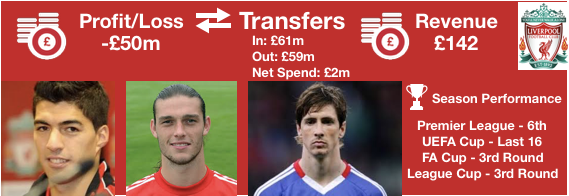
The story began on the 1stOctober 2010 when FSG paid a total consideration of £264m for a distressed Liverpool after the terrible period of ownership under Gillet and Hicks. The consideration consisted of:
- Cash of £220.2m (Cash of £224m less £3.8m already within the club)
- Acquisition costs of £6.5m
- The assumption of the previous owner’s debt of £37.7m
Revenue by the end of the accounting period (July each year) was £142m while a loss of £50m was incurred, showing the financial troubles the club were in. To help solve this, FSG negotiated an increase in their credit facilities from banks to £120m in September 2011.
In a show of ruthlessness ahead of an eventful transfer window, FSG sacked the underperforming Roy Hodgson and replaced him with club legend Kenny Dalglish on the 8thJanuary 2011, in a move that instantly gained the owners goodwill.
FSG arrived at a difficult time which was made more difficult by the sale of Torres to Chelsea, all proceeds were reinvested with the signings of Carroll (£37m) and Suarez (£24m) for a combined £61m who enjoyed very different careers at the club. Along with Torres (£53m), Babel (£6m) was also sold, leaving a net spend of a measly £2m.
Liverpool finished 6thafter the morale boost appointment of King Kenny, however this was still a below par league performance. This was compounded by poor cup performances with third round exits from the FA Cup and League Cup whilst they also exited the Europa League in the Last 16.
2011/12
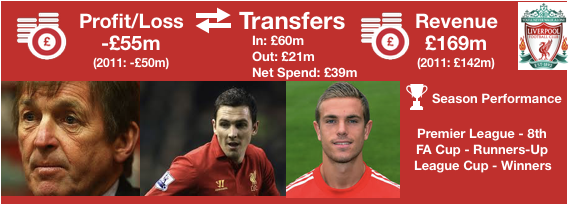
2011/12 was a mixed season for Liverpool. A poor Premier League campaign led to an 8thplaced finish which was below par, however the club reached the FA Cup final before losing to Chelsea and also won the League Cup, which is still the only trophy won in the FSG era despite a host of final appearances.
This was not enough to keep Dalglish in a job and he was sacked on 16th May 2012 and was replaced by Brendan Rodgers on the 30thMay 2012 as the club looked for a young manager to take the club forward, playing an attractive brand of football.
Off the pitch financial performance was also mixed, revenue rose by 19% to £169m however poor cost management under the previous owners and a need to spend led to a loss of £55m.
Another big nail in the coffin of Dalglish was the transfers and their lack of success. £60m was spent overhauling the squad with the signings of Downing (£21m), Henderson (£16m), Adam (£8m), Coates (£7m), Enrique (£7m) and Teixeira (£1m).
Out went Meireles (£12m), Ngog (£4m), Konchesky (£2m), Insua (£1m), Ayala (£1m) and Jovanovic (£1m) for £21m leading to a net spend of £39m.
None of the signings lit the world alight with only Henderson remaining after coming into his own later, however the signings were universally ridiculed and contributed to Dalglish’s dismissal.
2012/13
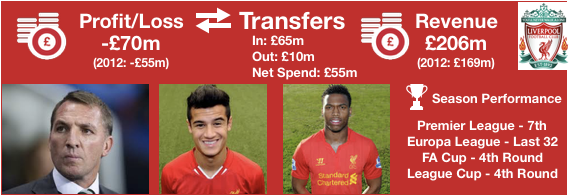
2012/13 was a poor season for Rodgers and FSG as the owners endured what was probably their most difficult season. Having sacked club legend Dalglish, Rodgers failed to galvanise the squad as they stumbled to a lowly 7thplaced finish, Fourth Round exits in both domestic cups and the Round of 32 in the Europa League.
FSG backed their new man spending £65m on Allen (£17m), Sturridge (£14m), Coutinho (£12m), Borini (£12m), Sahin (Loan – £5m), Assaidi (£4m) and Yesil (£1m) with Coutinho and Sturridge both proving terrific signings.
Out went Adam (£6m), Aqualani (£2m), Carroll (Loan – £1m) and Kuyt (£1m) for £10m at a total net spend of £55m.
Off the field the losses kept piling up despite rising revenues as Liverpool incurred losses of £70m, despite 22% revenue growth to £206m. In a show of intent, FSG also injected another £47m into Liverpool in August 2013.
FSG had brought themselves some extra goodwill early in the season as on the 15thOctober 2012, FSG announced their preference to redevelop Anfield rather than move to Stanley Park.
2013/14
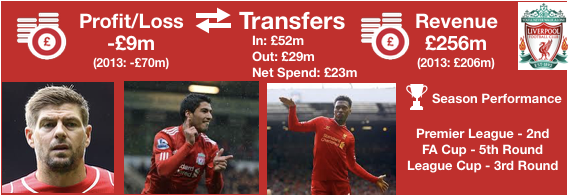
2013/14 was nearly a monumental season for Liverpool under their new manager who nearly gained legendary status as Liverpool were inches from winning the title before Gerrard’s notorious slip.
A second-place finish is the closest attempt Liverpool have had to winning the Premier League trophy. This was however coupled with yet again early cup exits (5th Round FA Cup & 3rdRound League Cup)
Financially there were huge improvements. Losses of only £9m were much smaller than any other year to date under FSG while revenue grew by 24% to £256m despite no European football due to a terrific domestic season. As another show of goodwill, FSG wrote off £6m of the loans owed to them by Liverpool.
Transfers didn’t prove to be crucial to their campaign, however there is always the what-if way of thinking if Liverpool had strengthened in January.
In came Sakho (£17m), Aspas (£10m), Mignolet (£10m), Luis Alberto (£7m), Ilori (£7m), Moses (Loan – £1m) and Cissokho (Loan – £1m) for a combined £52m, with only Mignolet proving crucial to Liverpool’s Premier League assault.
Out went Carroll (£16m), Shelvey (£5m), Downing (£5m), Borini (Loan – £2m) and Spearing (£1m) for a combined £29m, adding up to a £23m net spend.
2014/15
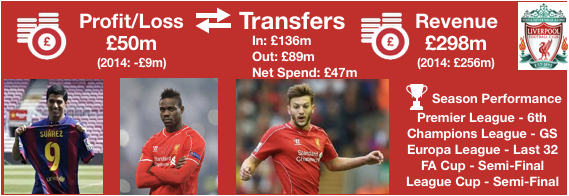
Having come so close to winning the Premier League, now was the time for Liverpool to shine and become regular title challengers. We all know this didn’t happen as Suarez managed to force through a move to Barcelona and his replacements failing to improve Liverpool is an understatement.
A dismal season ended in a 6thplaced Premier League finish and disappointing Semi-Final exits in both domestic cups. A return to the Champions League was meant to be exciting however it was a horrendous affair as the club were knocked out at the Group Stage by Basel and they didn’t fare much better in the Europa League after falling down into the competition, exiting at the Round of 32.
Off the field, a return to Champions League finally saw Liverpool make a profit of £50m. Revenue rose 16% to £298m as revenue continued its year-on-year growth. FSG continued to back Liverpool, plunging another £49m of cash into the club as they looked to continue moving forward after a poor season. FSG also renegotiated their credit facilities with banks to £150m in September 2015.
Transfers were the main culprit for their poor season.
In came Lallana (£28m), Lovren (£23m), Markovic (£23m), Balotelli (£18m), Moreno (£16m), Origi (£11m), Can (£11m), Lambert (£5m) and Manquillo (Loan – £2m) for a combined £136m.
Out went Suarez (£74m), Assaidi (£5m), Agger (£4m), Reina (£3m), Kelly (£2m), Suso (£1m) and Robinson (£1m) for £89.3m, a net spend of £47m however most of this money was a waste with only Lallana, Lovren and Can having decent spells at the club with Moreno and Origi also having a little success.
2015/16
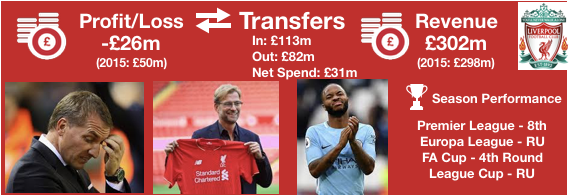
FSG have shown they will act when it is needed, showing ruthlessness, intent and ambition when on 4thOctober they sacked Brendan Rodgers and appointed Jurgen Klopp 4 days later, signalling a new era where the FSG machine has shone.
After a dismal start of the season saw the club languish in mid-table, Klopp improved the team despite finishing 8thin the Premier League as the club began their tags as nearly men, finishing Runners-Up in both the Europa League and League Cup, whilst they suffered an early 4thRound exit in the FA Cup.
With no Champions League and a poor Premier League campaign, revenue growth slowed, increasing by only 1% to £302m and they also returned to a loss-making position of £26m.
In a further show of intent, FSG plunged another £61m into the club in order to pay for the Anfield stadium expansion.
Prior to his departure, FSG showed Rodgers patience, shown by the summer transfer window where £113m was spent at a net spend of £31m.
In came Benteke (£42m), Firmino (£37m), Clyne (£16m), Ings (£7m), Grujic (£6m) and Gomez (£4m).
Departing were Sterling (£57m), Borini (£10m), Aspas (£5m), Lambert (£4m), Coates (£3m), Wisdom (Loan – £2m) and Grujic (Loan – £1m).
The signings failed to adjust early on, especially Firmino who has excelled under Klopp, while the signing of Benteke for a then club record, was the nail in the coffin for Rodgers as he departed his passing philosophy in signing the Belgian whilst Sterling was also missed.
2016/17
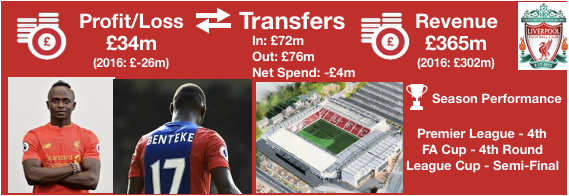
With no Europe as a distraction in Klopp’s first full season, the target of the Top 4 was achieved as the club finished 4thin the Premier League. The club also reached the Semi Final of the League Cup and 4thRound of the FA Cup.
Revenue was on the up once again after a lull in the prior year, rising 21% to £365m and the club also returned to profit as Liverpool made a profit of £34m.
At the beginning of the season Anfield was also expanded to 54,074 seats as the club looked to get more supporters into the ground and increase matchday revenue.
It was a conservative transfer window with net cash in of £4m as the club cut the purse strings slightly under the cost restraints of expanding a stadium, fortunately this was not a sign of things to come for Liverpool fans.
In came Mane (£37m), Wijnaldum (£25m), Karius (£6m) and Klavan (£5m) for a combined £72m outlay.
Leaving Anfield was Benteke (£28m), Ibe (£16m), Allen (£14m), Skrtel (£5m), Ilori (£4m), Smith (£3m) and Sakho (Loan – £2m) for a combined £76m.
The signings of Mane and Wijnaldum impressed and adapted seamlessly to Klopp’s tactic with Mane winning Liverpool Player of the Season.
2017/18
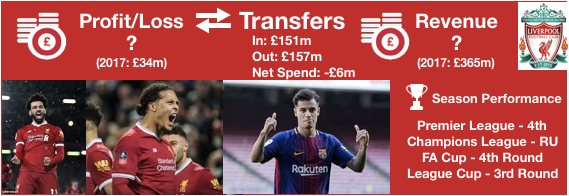
In Liverpool’s best year to date under FSG with optimism reaching a climax as Klopp led Liverpool to the Champions League Final. Alongside this was another 4thplaced Premier League finish. Early 3rdRound and 4thRound exits from the League Cup and FA Cup respectively were ignored.
A period of sheer optimism wasn’t slowed by the departure of Coutinho with Liverpool breaking the record for a defender with the signing of Van Djik.
FSG also announced plans to further expand Anfield to 61,000 seats as they look to compete with their rivals.
Transfer wise there was a net cash infusion with £6m entering the coffers however this paints a distorted picture with the signing of Naby Keita confirmed last season however only went through this year whilst the club were building a transfer assault this summer.
In came Van Dijk (£71m), Salah (£38m), Oxlade-Chamberlain (£34m) and Robertson (£8m) for a huge £151m with all the players proven shrewd purchases.
Departing Anfield was a host of players as Coutinho (£113m), Sakho (£25m), Origi (Loan – £6m), Lucas (£5m), Stewart (£4m), Wisdom (£2m) and Sturridge (Loan – £2m) leaving for a combined £157m.
FSG and Klopp were brave in many respects in January, letting Coutinho leave which could have caused massive disruption and going all out in buying Van Dijk for a world record fee (for a defender). It looks to have been the right move and has earned FSG much applaud.
Accounts for the financial performance last year is yet to be released with Liverpool having until next July to release them. We expect revenue to see a huge boost after their Champions League run which makes a return to profitability almost a certainty.
2018/19
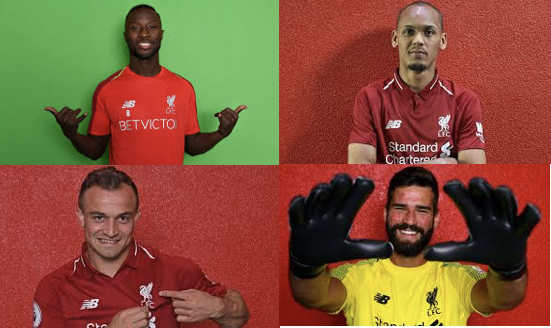
This summer could prove to have been a monumental one and a great success as Liverpool look to transition from a Top 4 hopeful to a regular title challenger. Investment in the squad was huge, targeting world-class players in positions of weakness, no more so than in goal after Karius’ Kiev nightmare.
In came Alisson (£56m), Keita (£54m), Fabinho (£41m) and Shaqiri (£13m) for a total of £164m with minimal outgoings outside Ward (£12m).
This investment has meant that optimism has peaked, and the club looks ready to be considered among Europe’s elite again.
Such investment, raised profile and solid financials have seen the club valued at above £2bn to FSG with such a bid rejected as they sense the start of something special.
The future only looks rosy for Liverpool and FSG after many tortuous times.
Thanks for reading, share with a Liverpool fan!

